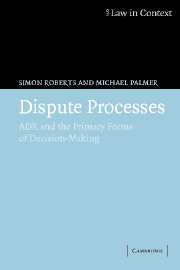Book contents
- Frontmatter
- Contents
- Preface
- Acknowledgements
- 1 Introduction
- 2 Cultures of Decision-making: Precursors to the Emergence of ADR
- 3 The Debates Around Civil Justice and the Movement Towards Procedural Innovation
- 4 Disputes and Dispute Processes
- 5 Negotiations
- 6 Mediation
- 7 Umpiring
- 8 Hybrid Forms and Processual Experimentation
- 9 The Trajectory of Alternative Dispute Resolution
- Bibliography
- Index
3 - The Debates Around Civil Justice and the Movement Towards Procedural Innovation
Published online by Cambridge University Press: 05 June 2012
- Frontmatter
- Contents
- Preface
- Acknowledgements
- 1 Introduction
- 2 Cultures of Decision-making: Precursors to the Emergence of ADR
- 3 The Debates Around Civil Justice and the Movement Towards Procedural Innovation
- 4 Disputes and Dispute Processes
- 5 Negotiations
- 6 Mediation
- 7 Umpiring
- 8 Hybrid Forms and Processual Experimentation
- 9 The Trajectory of Alternative Dispute Resolution
- Bibliography
- Index
Summary
Introduction
Across common law jurisdictions generally, the decades since 1960 have seen native institutions of civil disputing subject to more or less continuous re-examination and renovation. This process has taken place against the background of a particular jural inheritance, of which three foundational elements stand out. First is the historical dominance of state-sponsored adjudication, and hence of litigation, in the theory and practice of civil justice in the common law world. Second is the extent to which, as litigation has acquired a privileged status as the approved mode of dispute resolution, lawyers have through its practice achieved over generations a near monopoly over dispute management. The nature of this monopoly is only fully revealed when it is remembered that judicial appointment represents the ultimate career stage for the successful lawyer. Third is the manner in which lawyers have utilised civil procedure as the vehicle for their negotiation strategies, bringing about the profound entanglement of ‘settlement’ and ‘litigation’. Behind an ideology under which settlement remains virtually invisible and submerged, it is in practice pursued through use of the procedural framework prescribed for bringing a dispute to trial and judgment.
Disenchantment with this distinctive culture of disputing has generated some complex, overlapping conversations, for the most part recognisable earliest in the United States. These conversations have varied in pace and direction from one jurisdiction to another and are not readily subjected to generalisation.
- Type
- Chapter
- Information
- Dispute ProcessesADR and the Primary Forms of Decision-Making, pp. 45 - 78Publisher: Cambridge University PressPrint publication year: 2005

